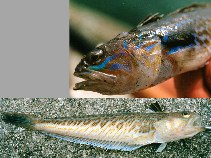| Family: |
Trachinidae (Weeverfishes) |
| Max. size: |
53 cm TL (male/unsexed); max.weight: 1,860.0 g |
| Environment: |
demersal; marine; depth range 1 - 150 m |
| Distribution: |
Eastern Atlantic: Norway to Morocco, Madeira and Canary Islands, including the Mediterranean and the Black Sea (Ref. 6790). Reported from Mauritania (Ref. 55783). |
| Diagnosis: |
Body elongate, length more than 6 times height. Greenish in upper parts, yellowish-white oblique stripes. Small 2-3 spines in front of each eye (Ref. 35388). |
| Biology: |
On sandy, muddy or gravelly bottoms, from a few meters to about 150 m. Rest on the bottom, often buried with eyes and tip of first dorsal fin exposed (Ref. 9988). At night they swim around freely, even pelagically (Ref. 35388). Feed on small invertebrates and fishes; chiefly nocturnal. Oviparous, eggs and larval stages pelagic (Ref. 4675). There are dark markings along the scales; the anterior dorsal fin is black and contains venomous spines. Utilized fresh and frozen; can be pan-fried, broiled, boiled and baked (Ref. 9988). Spawning takes place in June and August, pelagic eggs are 1 mm (Ref. 35388). Also Ref. 57406. |
| IUCN Red List Status: |
Least Concern (LC); Date assessed: 14 July 2014 Ref. (130435)
|
| Threat to humans: |
venomous |
Source and more info: www.fishbase.org. For personal, classroom, and other internal use only. Not for publication.
